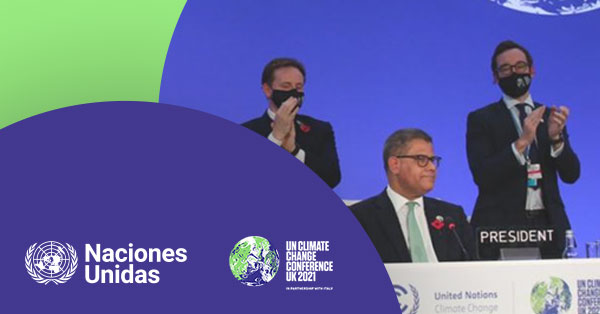
On Sunday 31, the Glasgow Climate Conference began with the remembrance of the victims of COVID-19 and after the opening statements all the bodies started their substantive work from there.
In the initial statements made during the opening plenary of the COP and at the World Leaders’ Summit, a common feature may be highlighted: the coincidence in the indispensability of climate action, in the extreme urgency to confront the crisis.
Indeed, the statements made by the different negotiating groups emphasised certain issues considered key by almost everyone, in particular, ambition in action.
Six years after the signing of the Paris Agreement (PA), and with climate impacts increasingly being felt around the world, COP26 was a first test of the agreement’s “ambition mechanism” to increase countries’ mitigation pledges over time.
This COP has just completed the consolidation of a firm commitment to the most ambitious global mitigation target of the PA’s 1.5°C, delivering the clearest and strongest signals of the conference.
Indeed, the persistent emissions gap has been clearly identified and Parties have collectively agreed to work to close that gap and ensure that the world continues to make progress this decade so that the average temperature increase is limited to 1.5 degrees. The 1.5°C target survives if countries’ pledges are met and commitments are translated into swift action.
In this regard, Parties are encouraged to strengthen their emission reductions and align their national climate action commitments with the Paris Agreement. Some of the main key outcomes of the COP in terms of mitigation have been:
• Countries are required to review and strengthen their 2030 targets by the end of 2022 (Paragraph 29, CMA 3).
• Convene ministerial roundtables to consider pre-2030 ambition starting at CMA 4 in 2022 (Paragraph 31, CMA 3).
On the other hand, there was a massive uptake of pledges towards the net zero carbon goal:
• 81 countries with almost ¾ of global emissions commit by 2050. In addition, some key countries have been added: India (2070), Saudi Arabia (2060), Nigeria (2060), UAE (2050), and the United Arab Emirates (2050).
Furthermore, the successive NDCs submitted by countries show progressive increases in ambition, particularly in terms of mitigation, although they are not yet sufficient to address the current climate crisis.
From the decisions taken, the way has been opened for Nationally Determined Contributions (NDCs) to be reviewed and strengthened by countries as necessary, in this instance in 2022. This is a substantive step forward for the COP. Moreover, the ministerial roundtables from COP27 onwards will contribute to advancing NDCs that are fully aligned with the Paris Agreement already in this decade.
However, NDC updates by countries remain patchy and out of 193 parties to the PA, only 46 have so far submitted their long-term low-emission development strategies (LTS).
The Glasgow Climate Pact has therefore extended the invitation for countries to submit their Long Term Low Carbon Development Strategies – originally due in 2020 – beyond that year.
On the other hand, some of the initiatives to reduce emissions by countries and non-state actors launched during the COP are unprecedented in terms of scope, ambition and relevance. It remains to be seen how they will be realised in practice in the coming years.
Because reducing emissions and decarbonising economies is urgent, progress was made especially on mitigation, and it was, in that sense, a COP focused on mitigation. However, the collective resolve to implement the NDCs must now be strengthened. This requires the means of implementation (funds, technologies, capacities), which have been slow to be delivered. Developed countries have not been up to the task in this area, although they promise to do better.







 Stay updated on the latest trends of Green Finance
Stay updated on the latest trends of Green Finance


